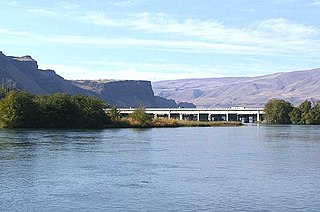
The Deschutes River in central Oregon is a major tributary of the Columbia River. The river provides much of the drainage on the eastern side of the Cascade Range in Oregon, gathering many of the tributaries that descend from the drier, eastern flank of the mountains. The Deschutes provided an important route to and from the Columbia for Native Americans for thousands of years, and then in the 19th century for pioneers on the Oregon Trail. The river flows mostly through rugged and arid country, and its valley provides a cultural heart for central Oregon. Today the river supplies water for irrigation and is popular in the summer for whitewater rafting and fishing.
The Cascade Lakes are a collection of lakes in central Oregon in the United States. The 12 lakes and two reservoirs are found along the east side of the Cascade Range in Deschutes County, Oregon. The lakes begin west of Mount Bachelor, just beyond the Mount Bachelor ski area. The first lake in the chain is Todd Lake. Heading west and south, Todd Lake is followed by Sparks Lake, Devils Lake, Elk Lake, Hosmer Lake, Lava Lake, Little Lava Lake, Cultus Lake and Little Cultus Lake. At the south end of the chain are Crane Prairie Reservoir, North and South Twin Lakes, Wickiup Reservoir, and Davis Lake.

Cultus Lake is a natural lake in Deschutes County in the U.S. state of Oregon. Formed by a glacier, it is located in the high Cascade Range in the Deschutes National Forest. The name is from the Chinook Jargon and means variously bad or worthless, or simply "in vain". In the early 19th century, the lakes in this area abounded with beavers. The earliest explorers to this area were primarily on a quest for furs.
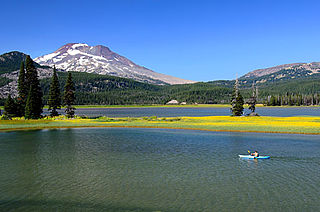
Sparks Lake is a natural body of water near the crest of the central Cascade Range in Deschutes County in the U.S. state of Oregon. The lake is about 26 miles (42 km) west-southwest of Bend along the Cascade Lakes Scenic Byway in Deschutes National Forest. Named for a 19th-century rancher, "Lige" Sparks, the water body is a remnant of a bigger lake that has partly filled with sediment and vegetation.

Lake Billy Chinook is a reservoir in Jefferson County in the U.S. state of Oregon. Created by the Round Butte Dam in 1964, Lake Billy Chinook lies in a canyon at the confluence of the Crooked, Deschutes, and Metolius rivers near Culver and Madras. It was named for Billy Chinook, a Native American of the Wasco tribe who traveled alongside American explorers John C. Frémont and Kit Carson in their expeditions of 1843 and 1844.

Odell Lake is located near Willamette Pass in the northwest corner of Klamath County, Oregon, United States. It is one of several lakes in the Cascade Range in Central Oregon, and lies within the Deschutes National Forest. It was named for Oregon Surveyor General William Holman Odell by Byron J. Pengra, in July 1865, while they were making a preliminary survey for the Oregon Central Military Road, which would later become Oregon Route 58. The lake fills a basin carved by a glacier, and the resulting terminal moraine confines the water along the lake's southeast shore.

Little Lava Lake lies in the Cascade Range about 26 miles (42 km) west-southwest of Bend in the U.S. state of Oregon. A close neighbor of Lava Lake, from which it is separated by solidified lava, Little Lava Lake is at an elevation of 4,744 feet (1,446 m) in the Deschutes National Forest. Generally considered the source of the Deschutes River, the lake covers 138 acres (56 ha) to an average depth of 8 feet (2.4 m).

The Ochoco Mountains are a mountain range in central Oregon in the United States, located at the western end of the Blue Mountains. They were formed when Permian, Triassic, and Jurassic rocks were slowly uplifted by volcanic eruptions to form the Clarno Formation. Today, the highest point in the range is Lookout Mountain. The dominant vegetation on the west side of the range is old-growth ponderosa pine; on the east side, western juniper is common. The western area of the mountains is administered by the Ochoco National Forest, while the southeastern section is part of the Malheur National Forest. The Ochoco Mountains are used for hiking, camping, bird watching, rockhounding, and hunting, as well as cross-country skiing in the winter.

Wickiup Reservoir is the second-largest reservoir in the U.S. state of Oregon. It is located 60 miles (97 km) southwest of Bend, and is the largest of the Cascade Lakes. Wickiup Reservoir is close to the Twin Lakes, Davis Lake, Crane Prairie Reservoir, Cultus Lake, and Little Cultus Lake. The reservoir is located within the Deschutes National Forest and the Fort Rock Ranger District, near the Cascade Lakes Scenic Byway.

Davis Lake straddles the border between Deschutes County and Klamath County in the U.S. state of Oregon. A relatively large and shallow lake in the Deschutes National Forest, it is located toward the south end of the Cascade Lakes Scenic Byway, near Oregon Route 58 and U.S. 97. The lake is known as one of Oregon's best bass lakes.
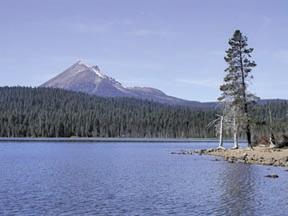
Lake of the Woods is a natural lake near the crest of the Cascade Range in the Fremont–Winema National Forest in southern Oregon in the United States. The lake covers 1,146 acres (4.64 km2). It was named by Oliver C. Applegate in 1870. Today, the Oregon Department of Fish and Wildlife manages the lake's fishery. The small unincorporated community of Lake of the Woods is located on the east shore of the lake. Lake of the Woods is one of southern Oregon's most popular outdoor recreation sites.
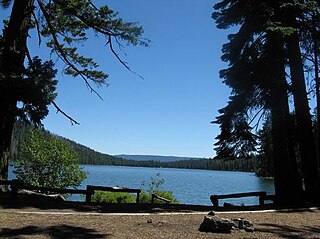
Suttle Lake is a natural lake near the crest of the Cascade Range in central Oregon, United States, covering 253 acres (1.02 km2). It was named in honor of John Settle, whose name was misspelled when the lake was officially recorded as a geographic feature. Today, the lake is located within the Deschutes National Forest and serves as one of central Oregon's most popular outdoor recreation sites, with three large campgrounds and two day-use areas along the south shore of the lake. The Oregon Department of Fish and Wildlife regularly stocks the lake with rainbow trout.

Elk Lake is a natural body of water in the central Cascade Range in the U.S. state of Oregon. Nearly 4,900 feet (1,500 m) above sea level, the lake is part of a volcanic landscape about 25 miles (40 km) west-southwest of Bend along the Cascade Lakes Scenic Byway.

Lava Lake lies in the Cascade Range about 25 miles (40 km) west-southwest of Bend in the U.S. state of Oregon. It is a close neighbor of Little Lava Lake, from which it is separated by solidified lava. Lava Lake is at an elevation of 4,740 feet (1,440 m) in the Deschutes National Forest. The lake covers 368 acres (149 ha) to an average depth of 20 feet (6.1 m).
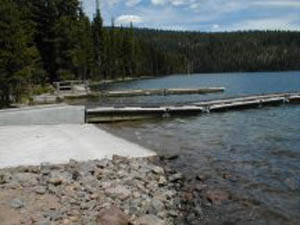
Miller Lake is a large natural freshwater lake in the Cascade Range in western Klamath County in the U.S. state of Oregon. The lake is in the Winema National Forest, about 14 miles (23 km) west of Chemult via Miller Lake Road.
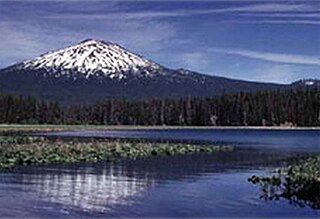
Hosmer Lake is a natural body of water in the central Cascade Range in the U.S. state of Oregon. Nearly 5,000 feet (1,500 m) above sea level, the lake is part of a volcanic landscape about 20 miles (32 km) west-southwest of Bend along the Cascade Lakes Scenic Byway. In 1962, the United States Board on Geographic Names changed the name from Mud Lake to Hosmer Lake in honor of Paul Hosmer, a naturalist from Bend.
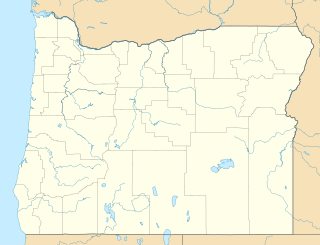
Doris Lake is a natural body of water in the Three Sisters Wilderness of the central Cascade Range in the U.S. state of Oregon. At 5,300 feet (1,600 m) above sea level, the lake is part of a volcanic landscape 27 miles (43 km) southwest of Bend and about 3 miles (5 km) by trail west of the Cascade Lakes Scenic Byway.

Jubilee Lake is a 92.33-acre (37.36 ha) man-made lake in the Umatilla National Forest in the northern corner of Union County in the U.S. state of Oregon. It is located 19 miles (31 km) north of Elgin and about 11 miles (18 km) south of the Washington border, at an elevation of 4,761 feet (1,451 m). Its basin spans Union, Umatilla, and Wallowa counties. The lake was made for recreation in 1968 when an earthen dam, 350 feet (110 m) long and 50 feet (15 m) high, was constructed on Motett Creek. A U.S. Forest Service campground at the lake has 53 sites and is the most heavily used campground in the Umatilla National Forest. Fishing and swimming are the most popular activities at the lake. A 2.8-mile (4.5 km) trail around the shore was designated a National Recreation Trail in 1981.

Todd Lake is a natural lake near the crest of the Cascade Range in central Oregon in the United States. The lake covers 45 acres (18 ha). It is named in honor of John Y. Todd, an early settler in Central Oregon. Today, the lake and surrounding forest is managed by the United States Forest Service as part of the Deschutes National Forest. The Oregon Department of Fish and Wildlife regularly stocks the lake with brook trout. There is a day-use area and a rustic campground located on the west shore of the lake. In the summer, Todd Lake is a popular outdoor recreation site for picnicking, fishing, hiking, and nature viewing. In the winter, trails in the Todd Lake area are used for cross-country skiing and snowshoeing.
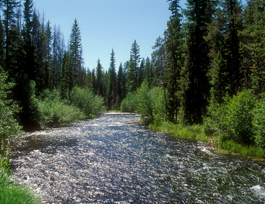
Crescent Creek is a 30-mile (48 km) tributary of the Little Deschutes River in Klamath County in the U.S. state of Oregon. Beginning at Crescent Lake on the eastern flank of the Cascade Range, the river flows generally east through parts of Deschutes National Forest to meet the Little Deschutes between Crescent and La Pine.





















